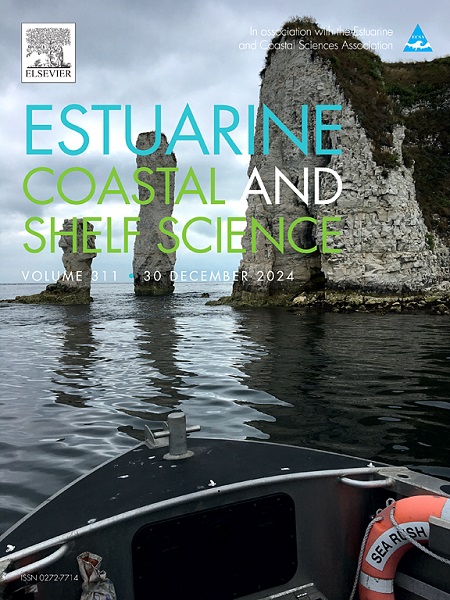Shellfish carbonate in sediments: assessing historical baselines, dissolution dynamics, and carbon storage beneath shellfish farms, Marlborough, New Zealand
IF 2.6
3区 地球科学
Q1 MARINE & FRESHWATER BIOLOGY
引用次数: 0
Abstract
Inorganic carbon (IC) in the form of calcium carbonate (CaCO3) produced by shellfish is a key but often overlooked component of estuarine sediments, now threatened by the decline of calcifying biogenic habitats. While biocalcification can be potentially a net emitter of CO2, shellfish shells also preserve paleobiological records that can inform pre-impact baselines and support ecosystem restoration alongside aquaculture developments. However, global stressors—including overharvesting, benthic disturbance, and increased aquaculture—have distorted the sedimentary record of CaCO3. We analysed sediment cores beneath three ca.40-year-old green-lipped mussel Perna canaliculus farms to assess shell deposition rates before and after aquaculture development. Mussel shells, including those from fouling species Mytilus galloprovincialis, dominated both periods, but post-farming deposition rates increased by an average of 8-fold. Old shells in deeper sediments were from historic wild mussel reefs reduced to ca.3 % of former biomass by the 1970s. We found statistically significant yet minor differences in OC and IC content between old and recent shells. These results demonstrate how shell accumulation beneath farms preserves valuable ecological archives and enhances benthic carbon stocks. Our findings offer a novel tool for aquaculture managers to reconstruct baseline conditions, monitor carbon contributions, and inform the use of shell waste in coastal rehabilitation strategies on soft sediments.
沉积物中的贝类碳酸盐:评估贝类养殖场的历史基线、溶解动力学和碳储量,马尔堡,新西兰
贝类产生的碳酸钙(CaCO3)形式的无机碳(IC)是河口沉积物的关键成分,但经常被忽视,现在受到钙化生物栖息地减少的威胁。虽然生物钙化可能是二氧化碳的潜在净排放源,但贝类壳也保存了古生物记录,可以为影响前的基线提供信息,并在水产养殖发展的同时支持生态系统恢复。然而,全球压力因素——包括过度捕捞、底栖生物干扰和水产养殖的增加——扭曲了CaCO3的沉积记录。我们分析了三个大约40岁的绿唇贻贝养殖场的沉积物岩心,以评估水产养殖发展前后的贝壳沉积率。贻贝(包括污染物种Mytilus galloprovincialis的贻贝)在这两个时期都占主导地位,但养殖后沉积率平均增加了8倍。深层沉积物中的旧壳来自历史悠久的野生贻贝礁,到20世纪70年代,这些贻贝礁的生物量减少了约3%。我们发现旧壳和新壳在OC和IC含量上有统计学上的显著差异。这些结果表明,农场下面的贝壳积累可以保存宝贵的生态档案,并增加底栖生物的碳储量。我们的研究结果为水产养殖管理者提供了一种新的工具,可以重建基线条件,监测碳贡献,并为在软沉积物上使用贝壳废物的沿海恢复策略提供信息。
本文章由计算机程序翻译,如有差异,请以英文原文为准。
求助全文
约1分钟内获得全文
求助全文
来源期刊
CiteScore
5.60
自引率
7.10%
发文量
374
审稿时长
9 months
期刊介绍:
Estuarine, Coastal and Shelf Science is an international multidisciplinary journal devoted to the analysis of saline water phenomena ranging from the outer edge of the continental shelf to the upper limits of the tidal zone. The journal provides a unique forum, unifying the multidisciplinary approaches to the study of the oceanography of estuaries, coastal zones, and continental shelf seas. It features original research papers, review papers and short communications treating such disciplines as zoology, botany, geology, sedimentology, physical oceanography.

 求助内容:
求助内容: 应助结果提醒方式:
应助结果提醒方式:


